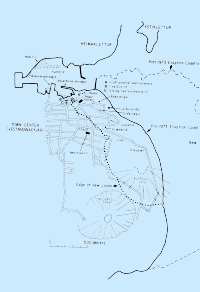Lava-Cooling Operations During the 1973 Eruption of Eldfell Volcano,
Heimaey, Vestmannaeyjar, Iceland
U.S. Geological Survey Open-File Report 97-724
|
by
| |||||||||||||||||||
The start of lava-cooling operations
The first attempt to prevent the advance of the lava by water cooling was made two weeks [7 Feb 73] after the eruption began [23 Jan 73], but by then the lava was dangerously close to the entrance to the harbor. Firemen from the fire department in Vestmannaeyjar started to spray seawater on the headwall of creeping lava, and it soon appeared to have some effect on the lava flow. Soon thereafter, more powerful pumps were ordered from the [Icelandic] mainland and from other countries. Gradually the number of pumps was increased, but at this stage the capacity never was very significant (about 100 l s-1).
|
|
Figure 3. Click on figure for larger image with caption. |
Fire hoses were used to spray water along about a 500-m-long stretch of the lava edge from Skans to Grænahlíð [east-west street about 0.4 km south of Skans; see fig. 3 in the Introduction for map of the town of Vestmannaeyjar and environs on Heimaey]. The lava along this stretch started to pile up, and the lava edge reached about 20 m in height and appeared rather unstable. The water did not seem to be utilized to its utmost, because every so often it flowed down along the lava edge. The pumping equipment on hand was not powerful enough to pump water to the top of the lava edge, and it was entirely out of the question to lay hoses up onto the lava edge, because it was both steep and hot and constantly moving.
By the latter part of February, the lava field had piled up on the [outer] breakwater. The dredging boat Sandey was used to strengthen the lava edge [by spraying seawater onto it], having arrived in Vestmannaeyjar on 1 March. About the same time, a section of the [new] mountain [northern part of the Eldfell crater wall] became loose [and began to be carried north by the lava flows]; it was given the name Flakkarann ["The Wanderer"]. It crept over the existing lava field aiming directly for the harbor entrance. The Sandey was given the task of preventing its advance.
The Sandey brought water pipes that were made of steel 22 inches (56 cm) in diameter.
Each pipe section was joined together with more than 40 bolts, which was a very slow process.
The lava, where the pipes were laid, was still moving and that increased the difficulty, because
joints split and the pipes broke. In spite of all that, it was possible to lay a pipeline about 200
meters eastwards on the lava at Skans.
An attempt was made to compute how much seawater the Sandy sprayed on the lava, but that was quite difficult, because it was hard to get to the pipe ends to measure the flow. Also, pumps were often stopped because of malfunctions in the pipes or because the ship had to be moved. According to the most reliable sources, it is estimated that the Sandy pumped about 400 l s-1, when the water was pumped up on the lava tongue 30 meters high, or a total of about 0.4 million metric tonnes of seawater.
The result of this cooling was quite visible. The lava tongue that was cooled did not move from that time on, in spite of a great pressure later caused by Flakkarann and additional lava that piled up to the south and west of the Flakkarann.
About that time people realized that, if the lava flow was to be stopped, far more powerful pumping equipment was needed. The equipment needed should be able to pump the water up to two or three times higher than the existing equipment was able to do.
On 11 March, a report was prepared and signed in Vestmannaeyjar by six men: Þorbjörn Sigurgeirsson, Sveinn Eiríksson, Þórhallur Jónsson, Pálmi R. Pálmason, Páll Zóphóníasson and Guðmundur Karlsson. In the report, three types of pumping equipment were mentioned (according to preference), that might be considered capable of preventing the lava from flowing into the harbor and/or the town. It was requested that the capacity be increased to about 800 l s-1 and the delivery head be increased up to 60 meters. Those, signing the report, estimated that this equipment had to be on hand within one week, if it was to be possible to save the harbor and town in Vestmannaeyjar. A little over two weeks later, on 26 March, the first delivery of pumping equipment came by air from the United States.
It has been seriously discussed, whether it would have been possible to stop the lava flow that started 8 weeks after the eruption and flowed in one week over one fifth of the houses in town. That lava flow covered the shortest distance from the crater, ran along the western edge of the older lava, and flowed into the town south and east of Grænahlíð. The lava tongue travelled slowly in the beginning. Its end lay on an artificial dike [rampart] that had been constructed from scoria; in two weeks, it was build to a height of 25 meters. By that time the lava tongue had become twice as high as the dike and overtopped it.
What would have happened if the pumping equipment had arrived one week before as the
group of six had requested? In answer to that, even if the pumps had arrived in the country on 18
March, and the pumping started 23-24 March, taking into consideration that it would have taken
5 to 6 days to transport them to Vestmannaeyjar and install the first phase, it would have been
impossible to stop the lava flow, which by then had [already] started to flow with great force.
